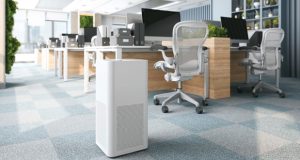 THE WASHROOM HYGIENE PROFESSIONAL’S VIEW
THE WASHROOM HYGIENE PROFESSIONAL’S VIEW
ANNA KÖNIGSON KOOPMANS,
MARKETING DIRECTOR, COMMERCIAL SEGMENT, ESSITY PROFESSIONAL HYGIENE
Essity’s Gothenburg offices have been equipped with pod-based unisex toilets for decades, so I am able to speak from experience. These types of washrooms generally work well. Queuing for the ladies’ is no longer an issue when people of all genders can use any cubicle. The fact that cleaners are not obliged to close down the entire facility to carry out their job means there is always washroom availability, which is another advantage. And pod-based toilets offer more privacy than communal facilities, which means users feel more comfortable when freshening up.
There is a theory, too, that people are more likely to leave their pod-based toilet in a sanitary condition than if they were in a communal facility. When exiting a “pod” there is no hiding place from whoever is waiting to use it. As a result, people are arguably less likely to leave behind a messy loo if there’s a chance they could face an embarrassing encounter with someone of the opposite sex outside.
And of course, during a pandemic there are obvious social-distancing advantages to replacing communal facilities with private washrooms.
As far as touch-free doors and dispensers are concerned, these are only really needed after the user has washed his or her hands to avoid the risk of recontamination. A supply of hand towels in a washroom pod assist a touch-free operation because these allow the user to open the door using a towel as a barrier.
There are downsides to pod-based toilets, though. They take up more space than communal washrooms and there is no back-up when the soap and paper supply runs out, for example. This means cleaners need to be particularly vigilant in order to keep on top of refill requirements.
Individual washrooms also tend to take longer to service because the cleaner needs to enter each pod individually. Furthermore, the privacy offered by these toilets could encourage employees to linger longer than they would do in a communal facility – and this could have a knock-on effect on productivity.
Communal gender-neutral toilets could of course be supplied instead, since these are an inclusive alternative to gents’ and ladies’ facilities while also taking up less space. Unisex washrooms also help to even out queues, which are usually longer for the ladies.
But some people – particularly women – feel uncomfortable when using a gender-neutral loo. For example, a YouGov study carried out in June 2021 revealed that only four per cent of women supported the replacement of male and female loos in restaurants, bars, hotels, cinemas and other public buildings with gender-neutral options.
In this age of inclusivity it does make sense to open up all washrooms to every gender. But this will only work if everyone is on board with the idea. Washroom providers need to put their users first and ask for their opinion.
The gender-neutral question definitely needs to be a part of the wider toilet debate, but washrooms should be inclusive in other ways, too. For example, they should be accessible to the less abled, the elderly and the very young as well as to those with temporary disabilities such as a broken bone or other injury. Because at the end of the day it is all about providing the types of washrooms that people want – and ensuring hygiene for all.
 THE ACCESS EXPERT’S VIEW
THE ACCESS EXPERT’S VIEW
ED WARNER,
CEO AND FOUNDER OF MOTIONSPOT, AND GOVERNMENT ACCESS AMBASSADOR – PRODUCT AND SPACES
Improving opportunities for previously marginalised demographics helps create more diverse and inclusive workforces. But for diversity and inclusion policies to be successful, organisations need to consider how their workplaces can be designed inclusively to remove barriers for employees and visitors.
One in five people across the world have a disability, so to design genuinely accessible and inclusive workplaces, businesses should consider the challenges in the workplace for staff or visitors with physical, cognitive, sensory, and social communication issues.
Adopting an inclusive mindset should also aim to prevent the exclusion of people with different abilities, age, gender, religion or spirituality, language, and cultural backgrounds.
Current research on the application of inclusive design suggests a generalised lack of understanding of the primary needs of employees in workplaces, from unconscious bias towards LGBTQIA+ communities to a misunderstanding of religion or spirituality habits, to exclusion for underrepresented minority groups.
Creating a safe work environment starts by acknowledging exclusion and designing spaces that accommodate the needs and aspirations of all people. Designing inclusive environments is not just a ‘nice-to-have’ but is a process based on a people-first approach that starts with understanding the different needs and desires of the customer, continues with the delivery stage and endures with constant facility maintenance.
It is important that organisations provide washrooms that are accessible to all whatever their physical challenges. Designing accessible and flexible workplaces should include the creation of step free entrances with handrails, resting areas and visual, sensory, and auditory wayfinding across the whole building. It is also important to ensure that in addition to wheelchair accessible toilets there are ambulant accessible toilet facilities that enable those who have difficulty walking to use the washrooms.
Those who identify as non-binary but work in an office that only has male and female designated toilet facilities may find that this has a negative impact on their sense of belonging in the workplace and may even prevent them from using the facility during the day. Providing the most basic of facilities that everyone can use safely and comfortably is vital for any inclusive business.
The solution would be to create a choice of toilet facilities, including all gender toilets alongside female/male only toilets as certain people and faiths require gender specific toilet facilities. It also involves destigmatising the use of traditional colours for males and females and designing a parents’ room that meets the needs of people of all genders.
Workplaces should also provide the right inclusive spaces and opportunities for people to manifest religious and spiritual beliefs. This requires the creation of washroom facilities with ablution and lavatories that respect religious and spiritual obligations.
I believe that designing more inclusive buildings and spaces reduces exclusion and fosters equity for everyone. This is because inclusive design produces universally appealing environments, helps organisations to hire and retain the best demographically, experientially, and cognitively diverse talent, improves satisfaction at work and provides long term cost savings by avoiding the need for expensive and environmentally damaging retrofits and adaptations in the future.
Our inclusive workspace white paper provides DE&I, HR and business leaders and their design teams with insight and inspiration to start making their workplaces more inclusive and can be downloaded at https://motionspot.co.uk/pages/designing-inclusive-workplaces-white-paper.
(i) www.fmj.co.uk/bco-looks-at-how-covid-19-will-change-the-workplace




